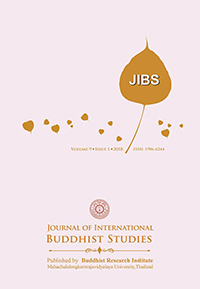A Comparative Study of the Meditation Techniques between Thai and Chinese Buddhist Traditions
Keywords:
Comparative Study, Meditation Techniques, Thai and Chinese Buddhist TraditionsAbstract
This is a comparative study of the meditation techniques between Thai and Chinese Buddhist traditions. On the ground of the knowledge of meditation practices in Pali and Chinese Buddhist canon and meditation techniques prevalent in Thailand and China, this research is to find the similarities and differences between them in way to organize meditation practice, the theoretical basis for meditation techniques, and similar meditation techniques in these two Buddhist traditions. This research finds that both Thai and Chinese meditation masters try to bring meditation into normal people’s daily life, by making meditation centers easily to reach, reducing the importance of studying scriptures, and leading meditators’ being confidence in Nibbana. However, there are also some differences between the meditation techniques in Thai and Chinese Buddhist Traditions. In Thailand, meditation courses are normally organized by meditation centers, while in China, temples are organizing meditation practices. What is more, though there are some similar meditation techniques in these two Buddhist traditions, such as contemplation on breathing, as well as recitation of “Boddho” and Nian-fo, they are from different Buddhist texts and belonging to different meditation subjects.
References
Bantaokul, Sudarat. An analytical Study of the Developmental Structure of the Taishō Tripiṭaka. Research report, Faculty of Buddhis, MCU, 2011, P.จ.
Buddhaghosa. The Path of Purification, trans. Bhikkhu Nanamoli. Kandy: BPS, 2011, p.273.
Bond, D.George. The Buddhist Revival in Sri Lanka: Religious Tradition, Reinterpretation and Response. Columbo: University of South Carolina Press, 1988.
Cook, Joanna. Meditation in Modern Buddhism: Renunciation and Change in Thai Monastic Life. New York: Cambridge University Press, 2010.
Faure, Bernard. Chan Insight and Oversights: An Epistemological Critique of the Chan Tradition. New Jersey: Princeton University Press.
Gethin, Rupert. The Buddhist Path to Awakening. Oxford: Oneworld Publications, 2001
Gunaratana, Henepola. The Jhānas in Theravāda Buddhist Meditation. http://www.accesstoinsight.org/lib/authors/gunaratana/wheel351 .html (Accessed 20 Dec, 2013).
Jan Yunhua(冉云华). “《中国早期禅法的流传和特点—慧皎、道宣 所著「习禅篇」研究》(The Propagation and Characteristic of Early Meditation in China: A Study on the Chapter of Meditation Practice by Huijiao and Daoxuan)”, in Hua-Kang Buddhist Journal. Taipei: The Chung-Hwa Institute of Buddhist Studies, No. 07.(1984): p.63-99.
Jinghui. 《中国佛教与生活禅》(Chinese Buddhism and Shenghuo Chan). Beijing: Religion and Culture Press, 2005, p.121.
Jittasubho, Teean. A Manual of Self-Awareness. Bangkok: Luangpor Teean Jittasubho Foundation, 1994, p.17.
Jordt, Ingrid. Burma’s Mass Lay Meditation Movement: Buddhism and the Cultural Construction of Power. Athens: Ohio University Press, 2007.
Rhys, Davids, ed. 1921-1925. The Pāli Text Society’s Pāli-English Dictionary. Oxford: PTS, 2007.
Wen, Tzungkuen. 《当代泰国佛教东北森林禅修传统中“称念佛陀”法 门之研究》(A Study of “The Repetition of Buddho” in the Northeast Forest Meditation Lineage in Modern Thailand),ftp://ttbc.no-ip.or g/%A5@%AC%C9%A6U%A6a%A4W%AEy%B3%A1%B8% EA%AE%C6%2F%ABn%B6%C7%A6%F2%B1%D0%B9%CF %AE%D1%C0%5D%201%2F037%20%BD%D7%A4%E5%2F %BA%D9%A9%C0%A6%F2%AA%FB%AAk%AA%F9%A4% A7%AC%E3%A8s.pdf (accessed 3 Oct, 2013).
Xuan, Fang(宣方). “《汉魏两晋禅学研究》(A Study on Chan Meditation in Han and Wei Dynasties)”. Ph.D. Dissertation. Institute for the Study of Buddhism and Religious Theory, Renmin University of China, 1998.







